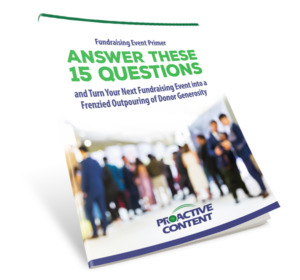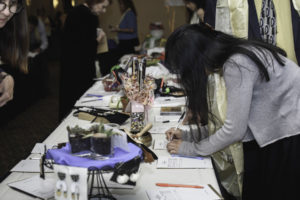You’ll be Shocked to See How Much Money Is Leaking from Your Fundraising Auction
8 Auction Revenue Sources and 3 Advanced Marketing Secrets
To extract the maximum revenue from your fundraising auction demands your creative attention on two different tiers.
Tier One includes auction activities common to many events. If your nonprofit does annual fundraising auctions, you may be using most of the eight on this list already. But check to see if you’re missing any that would be worth your time to include.
Tier Two injects advanced marketing psychology into the mix. These are the “secrets” that can boost good to great, acceptable to overflowing, and exciting to jaw-dropping.
If you want to get the maximum return on investment from your fundraising auction, then pay attention to what’s next. Figure out how you can inject Tier Two secrets into your next auction.
 How much better can your next auction perform? Get Your Free Fundraising Event Planning Guide
How much better can your next auction perform? Get Your Free Fundraising Event Planning Guide
Fill out the form to the right or click the button below.
Tier One: 8 Fundraising Auction Revenue Generators
To get the most money out a fundraising auction, you must do as many of these 8 revenue generators as possible. Don’t just do a live auction. Don’t just do a Fund a Need.
You might be thinking that the more stuff you add in, the more work it takes to plan. You’re right. And you must consider the amount of reliable volunteer help you’ll have in your auction planning committee and from others in the final weeks leading up to the event. You may not be able to do ALL of these, and that’s okay.
But you should use as many as you have resources to make happen.
Here are the 8 revenue generators in a fundraising auction:
-
Live Auction Items
Typically your highest value items go here. But doing a live auction requires a professional auctioneer. Don’t do a live auction without one. They are professionals for a reason. They know how to get money from a live crowd. You don’t. So make sure you have enough procured items that people will pay good money to win
If you need help, a superb auctioneer recommended by ProActive Content is Laura Michalek.
-
Silent Auction Items
Silent auctions take a lot more work than live ones, and they bring in less money. So why do them? Because they still bring in a lot of money! All your silent auction items will ideally be donated through your procurement process, so all your revenue is profit, minus any investments you put into your displays.
 Plus – and this is true of fundraising in any capacity – you must always consider your donors. Not everyone can afford to spend $900 for a live auction item. But they can afford to spend $150 on a silent auction one. More items mean more revenue, but more importantly, it also means more participation.
Plus – and this is true of fundraising in any capacity – you must always consider your donors. Not everyone can afford to spend $900 for a live auction item. But they can afford to spend $150 on a silent auction one. More items mean more revenue, but more importantly, it also means more participation.
And, different people prefer different ways of participating. Never forget that. Offer only one way, and you turn off the guests who prefer other ways.
How many silent auction items should you have? Research, data, and experience continue to inform on this question. As a starting rule of thumb, look for a 1:4 ratio of items to guests. So 50 items for 200 guests. You want some competition and bidding wars. Too many items will actually lower your revenue.
-
Fund-a-Need
This is where you just straight up ask for money. No items are given in exchange. Again, a professional fundraising auctioneer is critical to maximizing this.
The best way to run a fund-a-need is to tie each amount to its impact. $2000 pays for 5 dogs to be sheltered for a year. $5000 pays for the utilities for the orphanage for a year. $1500 gives one human trafficking victim health care and counseling.
Put impact into the dollar amounts, and donors will respond. This cannot be overstated in its importance. Do not just put random numbers up with no context.
-
Sponsors
Event sponsors – if you win enough of them – can cover all your upfront expenses. But these also rely heavily on relationship-building with businesses and foundations. They take time to develop and must be nurtured continually.
-
Ticket Sales
How much should you charge for fundraising auctions? Generally, the answer is…. more. You want people coming who can afford to spend money. Otherwise, you’ll have a dead crowd and a frustrated auctioneer.
That said – if you don’t have a ton of wealthy supporters, don’t price out all the supporters you do have. But, scale down the event accordingly.
Not sure if your nonprofit should even do a fundraising auction? 
Contact ProActive Content for a free 60-minute chat, and I’ll help you decide if it’s a wise choice (and it really might not be).
-
Fundraising Games
Yes, you need to do these. Absolutely. In my opinion, if you don’t do at least one game, then don’t do the event.
 Why? Two simple reasons: They’re super easy, and they’re super fun! Everyone loves them. The raffles I’ve seen typically get over 50% of participants to play, sometimes as high as 70%. 70% participation in anything is worth doing, for that reason alone. Especially when it’s something this simple.
Why? Two simple reasons: They’re super easy, and they’re super fun! Everyone loves them. The raffles I’ve seen typically get over 50% of participants to play, sometimes as high as 70%. 70% participation in anything is worth doing, for that reason alone. Especially when it’s something this simple.
Again – this is about your donors. You want them to enjoy your auction. Games are fun. It doesn’t matter if they “only” raise a few thousand dollars.
There are all kinds of fundraising auction games like raffles, Heads or Tails, Golden Ticket, and others. The important thing is – make the prize of higher value than a typical silent auction item.
-
Desserts
There are a few ways you can profit from desserts. The Dessert Dash is a favorite. This is where each table decides how much to bid, and the highest bidding table gets the first choice. But the second highest table will be called up right behind them, so they better hurry and get the dessert they want. Again – lots of fun. 
Challenges include procuring enough desserts. But a few good volunteers who excel at baking can fill out a dessert auction. Most bakeries are willing to donate as well.
Another way is to just auction off each dessert. If you only have five desserts, this is a better option than a Dash. Desserts can bring in thousands in revenue.
-
Table Decorations
How can you make money from decorations? First – you can sell centerpieces. This can be more work than it’s worth, so it depends on what you’re selling.
Another “decoration” is to include donation envelopes. Think about this: If out of an entire fundraising auction you get just one recurring donor through one of these envelopes, that donor might give hundreds or thousands of dollars over the next few years.
Tier Two: Advanced Auction Secrets from the Hidden Treasure Chest 
Okay, so you’ve got the basics. Maybe you even skimmed through those first 8 items thinking, “Tell me something I don’t know.” If so, maybe you should be writing this article.
These final three ideas are strategies based on psychological marketing principles, and they can be applied to almost all of the revenue-generators listed above. It takes advanced planning and creativity, and a willingness to try new things, to use these principles in your fundraising auctions.
But the rewards can mean tens of thousands in revenue you wouldn’t have otherwise received.
Secret #1: Limited Offers
When only a few people get to do something, it automatically makes it more desirable. When that ‘something’ involves a prize or experience that people already would want, the effect multiplies.
Find ways to inject limited offers into your fundraising auctions, and people will respond.
A few examples include:
- Early bird ticket pricing – must respond by this date (limited time offer)
- First three whole-table purchases get a special gift and a bonus $100 auction bucks (limited availability offer)
- First 5 people to give $2500 in the Fund a Need receive a personalized gift from the children they are supporting
- Only 50 people can buy Golden Tickets, and no more
The number of creative ways you can use the concept of limited offers is boundless because fundraising auctions have so many different moving parts.
Secret #2: Exclusivity
People like being part of a club. A special group that gets special privileges. Here are a few ways this can look (again – the applications of this principle have no limit – this is just to get your creative juices flowing):
- Buy two seat tickets, and get a free raffle ticket
- Attendees who buy four tickets can bid on items at a special silent auction table
- Buy before this date, and get entered in a special drawing
- Give $1000 in Fund a Need, and get invited to a special dinner with a celebrity
Once you start thinking this way, you’ll never plan your fundraising auctions the same way again.
Secret #3: Matching
You might know about matching. Many fundraisers do. But – do you use it in your auctions?
The most common uses are to get a major donor to give a matching grant before the auction and then use it in the Fund a Need. For example, a donor pledges $20,000. So now, if 10 attendees give $2000 in the Fund a Need, the donor will double it. 20k becomes 40k. It works.
But there are other ways to use the matching principle.
For instance, in your live auction, some items can be given away more than once. A professional auctioneer knows how to do this. Two bidders keep outdoing each other. Who wins? Both of them! Let the loser have the same item for the price the winner paid. You just doubled your revenue. Just make sure you have approval from the item donor beforehand.
More Fundraising Auction Secrets
This is a taste of what’s possible. Use your own creativity to turn your routine event into a night of surprises, winners, AND impact for the cause you’re fighting for. Discuss your next event plan with ProActive Content for 60 minutes free, and find ways to get more revenue.
But fundraising auctions begin with planning.
A poorly planned event will fail to raise the revenue it should have. In the sidebar to the right, fill out that form and get your free Fundraising Event Planning Guide – 15 questions you must ask and answer before you begin planning your next event.
Fill out the form to get your free guide, or click the button below.

